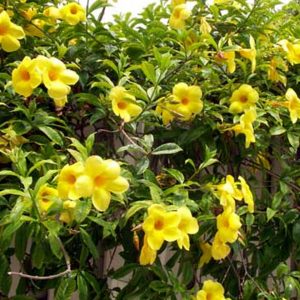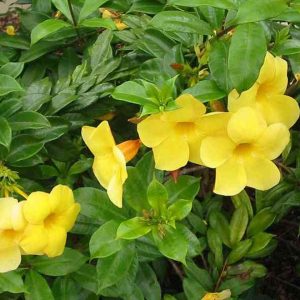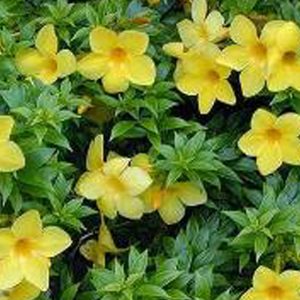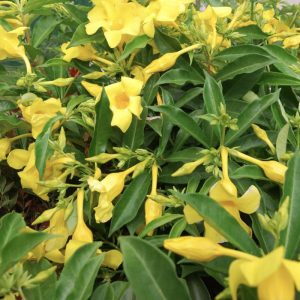If you love the cherry color that yellow brings to a landscape then Allamanda is a plant for you! All of them are extremely sun and heat loving and will thrive in those conditions. There are several varieties of Allamanda and not all of them are yellow. Here are three of the most popular varieties:
A full sun vine that tolerates salt, heat, drought, and is deer resistant! Big, bright golden yellow or burgundy ( Cherries Allamanda) flowers cover the vine from spring through fall. Planting in spring or summer enables the plant to establish a root system before going into winter allowing the plant to recover if winter damaged. Avoid northern exposures. A great plant that will provide lots of color for those hot sunny walls! Allamanda does not grow on tendrils so it would have to be trained onto a trellis. It can grow 6’-10’ if not trimmed occasionally and 4’-6’ wide.
A full sun shrub that tolerates salt, heat, drought, and is deer resistant! Big, bright golden yellow flowers cover the vine from spring through fall. Planting in spring or summer enables the plant to establish a root system before going into winter allowing the plant to recover if winter damaged. Avoid northern exposures. A great plant that will provide lots of color for those hot sunny walls! This shrub can grow upwards to 6’ if not trimmed occasionally and 3’-4’ wide. Makes a wonderful screen or accent plant!
A profuse bloomer with lots of bright yellow flowers that stand out well against the deep, green foliage. A semi-tropical plant that loves the sun, tolerates salt well if planted back from the front dunes, and blooms 10-11 months out of the year. Plant in sunny locations, in containers, or hanging baskets. Protect during freezes – established plants normally recover quickly in spring if cold damaged. Fertilize in spring with slow release granular bloomer. This is a dwarf form of Allamanda and will grow between 2’-3’ high and wide.
The plant is a vigorous, rambling woody climber that can get up to 15 feet tall, although it can be pruned to grow as a shrub with a more compact shape, especially when grown in a container. Because it does not twine or have tendrils, if grown as a vine it must be trained onto a trellis or other support structure. The wavy-margined, obovate leaves are 4-6 inches long. The whorls of 2-4 large, glossy, leathery leaves set off the flamboyant flowers in dramatic fashion. It can grow quite large, so may not be an appropriate house plant unless you have a lot of room.
Allamanda flowers primarily in the summer and fall. The large (to 5 inches across), trumpet shaped blossoms are composed of 5 large overlapping petals, that flare widely. There are both single and double forms. The clusters of flowers occur at the tip of new shoots. There can be one to several flowers in each cluster. When pollinated, green, spiny, round seed capsules may follow the flowers. Hummingbirds will visit the flowers.
Stop by and check out the Plant of the Week!



